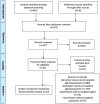Bevacizumab for radiation necrosis following radiotherapy of brain metastatic disease: a systematic review & meta-analysis
- PMID: 33593308
- PMCID: PMC7885379
- DOI: 10.1186/s12885-021-07889-3
Bevacizumab for radiation necrosis following radiotherapy of brain metastatic disease: a systematic review & meta-analysis
Abstract
Background: Radiotherapy is the mainstay of brain metastasis (BM) management. Radiation necrosis (RN) is a serious complication of radiotherapy. Bevacizumab (BV), an anti-vascular endothelial growth factor monoclonal antibody, has been increasingly used for RN treatment. We systematically reviewed the medical literature for studies reporting the efficacy and safety of bevacizumab for treatment of RN in BM patients.
Materials and methods: PubMed, Medline, EMBASE, and Cochrane library were searched with various search keywords such as "bevacizumab" OR "anti-VEGF monoclonal antibody" AND "radiation necrosis" OR "radiation-induced brain necrosis" OR "RN" OR "RBN" AND "Brain metastases" OR "BM" until 1st Aug 2020. Studies reporting the efficacy and safety of BV treatment for BM patients with RN were retrieved. Study selection and data extraction were carried out by independent investigators. Open Meta Analyst software was used as a random effects model for meta-analysis to obtain mean reduction rates.
Results: Two prospective, seven retrospective, and three case report studies involving 89 patients with RN treated with BV were included in this systematic review and meta-analysis. In total, 83 (93%) patients had a recorded radiographic response to BV therapy, and six (6.7%) had experienced progressive disease. Seven studies (n = 73) reported mean volume reductions on gadolinium-enhanced T1 (mean: 47.03%, +/- 24.4) and T2-weighted fluid-attenuated inversion recovery (FLAIR) MRI images (mean: 61.9%, +/- 23.3). Pooling together the T1 and T2 MRI reduction rates by random effects model revealed a mean of 48.58 (95% CI: 38.32-58.85) for T1 reduction rate and 62.017 (95% CI: 52.235-71.799) for T2W imaging studies. Eighty-five patients presented with neurological symptoms. After BV treatment, nine (10%) had stable symptoms, 39 (48%) had improved, and 34 (40%) patients had complete resolution of their symptoms. Individual patient data was available for 54 patients. Dexamethasone discontinuation or reduction in dosage was observed in 30 (97%) of 31 patients who had recorded dosage before and after BV treatment. Side effects were mild.
Conclusions: Bevacizumab presents a promising treatment strategy for patients with RN and brain metastatic disease. Radiographic response and clinical improvement was observed without any serious adverse events. Further class I evidence would be required to establish a bevacizumab recommendation in this group of patients.
Keywords: Adverse events; Bevacizumab (BV); Dexamethasone (Dex); MRI imaging; Radiation necrosis (RN).
Conflict of interest statement
None
Figures



Similar articles
-
Bevacizumab vs laser interstitial thermal therapy in cerebral radiation necrosis from brain metastases: a systematic review and meta-analysis.J Neurooncol. 2021 Aug;154(1):13-23. doi: 10.1007/s11060-021-03802-x. Epub 2021 Jul 3. J Neurooncol. 2021. PMID: 34218396
-
Treatment of cerebral radiation necrosis with bevacizumab: the Cleveland clinic experience.Am J Clin Oncol. 2015 Jun;38(3):304-10. doi: 10.1097/COC.0b013e31829c3139. Am J Clin Oncol. 2015. PMID: 23799286
-
Bevacizumab Treatment of Radiation-Induced Brain Necrosis: A Systematic Review.Front Oncol. 2021 Mar 25;11:593449. doi: 10.3389/fonc.2021.593449. eCollection 2021. Front Oncol. 2021. PMID: 33842309 Free PMC article.
-
Bevacizumab as a treatment for radiation necrosis of brain metastases post stereotactic radiosurgery.Neuro Oncol. 2013 Sep;15(9):1257-63. doi: 10.1093/neuonc/not085. Epub 2013 Jun 27. Neuro Oncol. 2013. PMID: 23814264 Free PMC article.
-
Bevacizumab as an effective treatment for radiation necrosis after radiotherapy for melanoma brain metastases.Melanoma Res. 2017 Dec;27(6):580-584. doi: 10.1097/CMR.0000000000000389. Melanoma Res. 2017. PMID: 28817446
Cited by
-
Can low-dose intravenous bevacizumab be as effective as high-dose bevacizumab for cerebral radiation necrosis?Cancer Sci. 2024 Feb;115(2):589-599. doi: 10.1111/cas.16053. Epub 2023 Dec 25. Cancer Sci. 2024. PMID: 38146096 Free PMC article.
-
Dosimetric and clinical analysis of pseudo-progression versus recurrence after hypo-fractionated radiotherapy for brain metastases.Radiat Oncol. 2023 Feb 14;18(1):30. doi: 10.1186/s13014-023-02214-7. Radiat Oncol. 2023. PMID: 36788610 Free PMC article.
-
Bevacizumab vs laser interstitial thermal therapy in cerebral radiation necrosis from brain metastases: a systematic review and meta-analysis.J Neurooncol. 2021 Aug;154(1):13-23. doi: 10.1007/s11060-021-03802-x. Epub 2021 Jul 3. J Neurooncol. 2021. PMID: 34218396
-
Cost-effectiveness analysis of bevacizumab for cerebral radiation necrosis treatment based on real-world utility value in China.Strahlenther Onkol. 2024 Sep;200(9):805-814. doi: 10.1007/s00066-024-02242-6. Epub 2024 Jun 3. Strahlenther Onkol. 2024. PMID: 38829437
-
Palliative care and end-of-life care in adults with malignant brain tumors.Neuro Oncol. 2023 Mar 14;25(3):447-456. doi: 10.1093/neuonc/noac216. Neuro Oncol. 2023. PMID: 36271873 Free PMC article.
References
-
- Tabouret E, Chinot O, Metellus P, Tallet A, Viens P, Gonçalves A. Recent trends in epidemiology of brain metastases: an overview. Anticancer Res. 2012;32(11):4655–4662. - PubMed
Publication types
MeSH terms
Substances
LinkOut - more resources
Full Text Sources
Other Literature Sources
Medical

